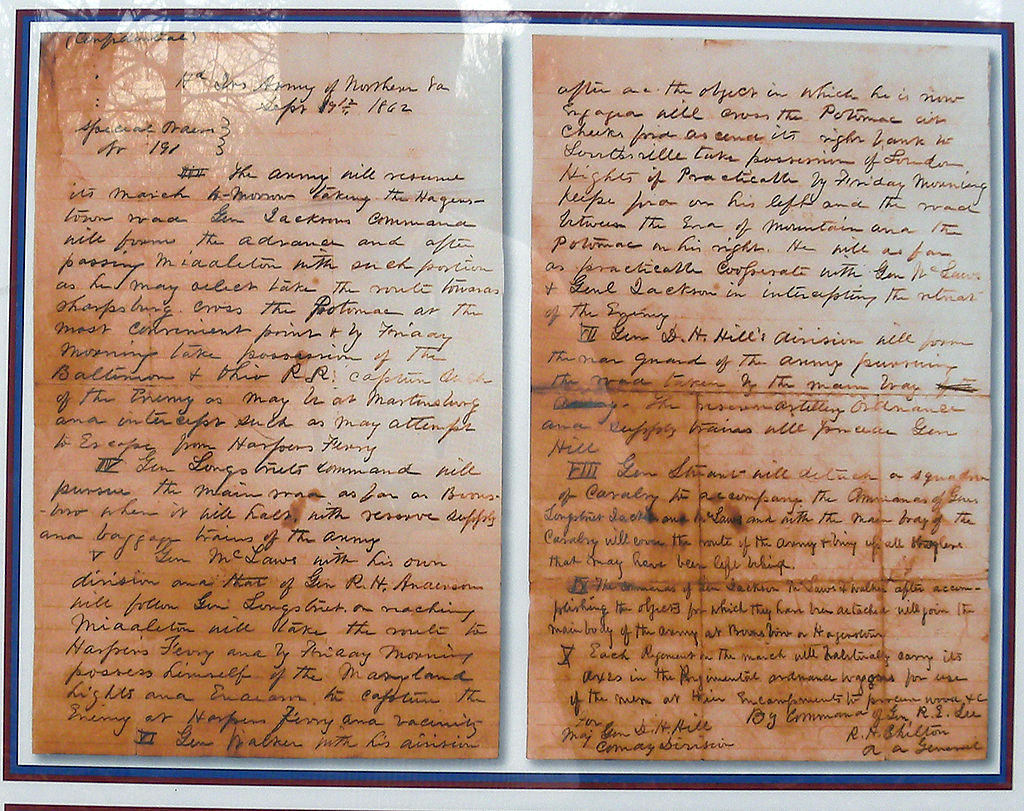Good morning, Whitewater.
Tuesday in the city will see thunderstorms this morning, then cloudy skies in the afternoon, with a high of seventy-five. Sunrise is 6:33 AM and sunset 7:06 PM, for 12h 32m 39s of daytime. The moon is a waxing gibbous with 86.1% of its visible disk illuminated.

By Wilson44691 – Own work, CC BY-SA 3.0, https://commons.wikimedia.org/w/index.php?curid=17489610 via Wikipedia.
On this day in 1862, Union soldiers discover Robert E. Lee’s Special Order 191, battle plans for a Maryland campaign:
Special Order 191 (series 1862) (the “Lost Dispatch,” and the “Lost Order“) was a general movement order issued by Confederate Army General Robert E. Lee in the Maryland Campaign of the American Civil War. A lost copy of this order was recovered in Frederick County, Maryland, by Union Army troops, and the subsequent military intelligence gained by the Union played an important role in the Battle of South Mountain and Battle of Antietam….
The order was drafted on or about September 9, 1862, during the Maryland Campaign. It gave details of the movements of the Army of Northern Virginia during the early days of its invasion of Maryland. Lee divided his army, which he planned to regroup later: according to the precise text Maj. Gen. Stonewall Jackson was to move his command to Martinsburg while McLaws’s command and Walker’s command “endeavored to capture Harpers Ferry.” Maj. Gen. James Longstreet was to move his command northward to Boonsborough. D. H. Hill‘s division was to act as rear guard on the march from Frederick.
Lee delineated the routes and roads to be taken and the timing for the investment of Harpers Ferry. Adjutant Robert H. Chiltonpenned copies of the letter and endorsed them in Lee’s name. Staff officers distributed the copies to various Confederate generals. Jackson in turn copied the document for one of his subordinates, Maj. Gen. D. H. Hill, who was to exercise independent command as the rear guard. Hill said the only copy he received was the one from Jackson.[1]
About noon [2] on September 13, Corporal Barton W. Mitchell of the 27th Indiana Volunteers, part of the Union XII Corps, discovered an envelope with three cigars wrapped in a piece of paper lying in the grass at a campground that Hill had just vacated. Mitchell realized the significance of the document and turned it in to Sergeant John M. Bloss. They went to Captain Peter Kopp, who sent it to regimental commander Colonel Silas Colgrove, who carried it to the corps headquarters. There, an aide to Brig. Gen. Alpheus S. Williams recognized the signature of R. H. Chilton, the assistant adjutant general who had signed the order. Williams’s aide, Colonel Samuel Pitman, recognized Chilton’s signature because Pitman frequently paid drafts drawn under Chilton’s signature before the war. Pitman worked for a Detroit bank during the period when Chilton was paymaster at a nearby army post.[3]Williams forwarded the dispatch to Maj. Gen. George B. McClellan, the commander of the Army of the Potomac. McClellan was overcome with glee at learning planned Confederate troop movements and reportedly exclaimed, “Now I know what to do!” He confided to a subordinate, “Here is a paper with which, if I cannot whip Bobby Lee, I will be willing to go home.”[4]
McClellan stopped Lee’s invasion at the subsequent Battle of Antietam, but many military historians believe he failed to fully exploit the strategic advantage of the intelligence because he was concerned about a possible trap (posited by Maj. Gen. Henry W. Halleck) or gross overestimation of the strength of Lee’s army.
JigZone has a puzzle of a flamingo for today:
